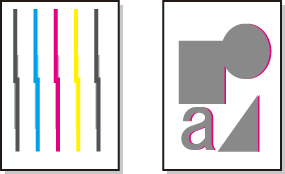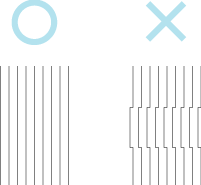7. 2. 1. Adjustments for Better Print Quality > Adjusting the Printhead >
Adjusting the Printhead
Adjusting the Printhead
•Printing is faint or affected by banding in different colors
Execute Nozzle Check to check for printhead nozzle clogging.
For instructions, see "Checking for Nozzle Clogging (11.2.2)."
•Printed vertical lines are warped or colors are out of alignment
Execute Head Posi. Adj. to adjust the printhead position.
Normally, execute Auto(Standard), Auto(Advanced), or Auto(Expansion). However, when using special paper or if printing is not improved after executing Auto(Advanced), try Manual.
(See "Automatic Adjustment to Straighten Lines and Colors (Head Posi. Adj.) (7.2.2).")
(See "Manual Adjustment to Straighten Lines and Colors (Head Posi. Adj.) (7.2.3).")
•Paper rubs against the printhead, or image edges are blurred
Executing Head Height to adjust the printhead height may improve printing results.
(See "Troubleshooting Paper Abrasion and Blurry Images (Head Height) (7.2.4).")
7. 2. 2. Adjustments for Better Print Quality > Adjusting the Printhead >
Automatic Adjustment to Straighten Lines and Colors (Head Posi. Adj.)
Automatic Adjustment to Straighten Lines and Colors (Head Posi. Adj.)
If vertical lines in printed documents are warped or colors are out of alignment, execute Head Posi. Adj.. The printer will print and read a test pattern, and the Printhead position will be adjusted automatically.
There are three modes for automatic Printhead adjustment: Auto(Standard), Auto(Advanced) and Auto(Expansion).
•Auto(Standard)
Fixes slight distortion and color misalignment.
•Auto(Advanced)
Try adjustment in this mode if Auto(Standard) does not improve printing.
•Auto(Expansion)
Try adjustment in this mode if vertical lines are warped or colors are out of alignment when the printer driver option High-Precision Photographs or High-Precision Text and Fine Lines is selected.
 |
| Important | ||
|
• This function is not available with CAD Tracing Paper or CAD Translucent Matte Film.
If adjustment is not possible as expected using highly transparent film or similar media, try another type of paper, or try Manual adjustment.
(See "Manual Adjustment to Straighten Lines and Colors (Head Posi. Adj.) (7.2.3).")
|
||
| Note | ||
|
• Because the results of adjustment vary depending on the type of paper used for adjustment, use the same type of paper as you will use for printing. Even if you will print on a different type of paper, we recommend using Auto(Advanced) for adjustment.
• If Auto(Advanced) does not improve printing, try adjustment in Manual mode.
(See "Manual Adjustment to Straighten Lines and Colors (Head Posi. Adj.) (7.2.3).")
• Advanced adjustment can enable superior printing quality when printing fine lines or text at high precision on glossy or semi-glossy photo or proofing paper.
(See "Enhancing Printing Quality (7.1.1).")
|
||
Items to Prepare
Perform adjustment as follows.
- Load the paper.
•Loading Rolls on the Roll Holder (6.2.1)•Loading Rolls in the Printer (6.2.2)•Loading Sheets in the Feed Slot (6.3.1)

Important • Always make sure the loaded paper matches the type of paper specified on the printer. Adjustment cannot be completed correctly unless the loaded paper matches the settings. - On the Tab Selection screen of the Control Panel, press
 or
or  to select the Settings/Adj. tab (
to select the Settings/Adj. tab ( ).
).


Note • If the Tab Selection screen is not displayed, press the Menu button. - Press the OK button.
The Set./Adj. Menu is displayed.
- Press
 or
or  to select Adjust Printer, and then press the OK button.
to select Adjust Printer, and then press the OK button. - Press
 or
or  to select Head Posi. Adj., and then press the OK button.
to select Head Posi. Adj., and then press the OK button. - Press
 or
or  to select Auto(Standard), Auto(Advanced), or Auto(Expansion), and then press the OK button.
A test pattern is printed for adjustment.Adjustment is now finished if you have printed on a roll.
to select Auto(Standard), Auto(Advanced), or Auto(Expansion), and then press the OK button.
A test pattern is printed for adjustment.Adjustment is now finished if you have printed on a roll.
Note • Auto(Expansion) may be unavailable in some cases, even if it is displayed in the menu.If so, execute Auto(Advanced) once. - If you are printing on sheets, a confirmation message is displayed requesting you to continue printing. Press the OK button and follow the instructions displayed.
7. 2. 3. Adjustments for Better Print Quality > Adjusting the Printhead >
Manual Adjustment to Straighten Lines and Colors (Head Posi. Adj.)
Manual Adjustment to Straighten Lines and Colors (Head Posi. Adj.)
If printed vertical lines are warped or colors are out of alignment, execute Head Posi. Adj. to adjust the Printhead alignment.
Normally, execute Auto(Standard), Auto(Advanced), or Auto(Expansion).
(See "Automatic Adjustment to Straighten Lines and Colors (Head Posi. Adj.) (7.2.2).")
However, when printing on special paper, or if printing is not improved after Auto(Advanced), try Manual.
Manual adjustment requires you to examine the printed test pattern and enter an adjustment value.
 |
| Note | ||
|
• Manual may be unavailable in some cases, even if it is displayed in the menu.
If so, execute Auto(Advanced) once.
• Always make sure the loaded paper matches the type of paper specified on the printer. Adjustment cannot be completed correctly unless the loaded paper matches the settings.
• We recommend using the type of paper you use most often for adjustment.
|
||
Items to Prepare
Perform adjustment as follows.
- Load the paper.
- On the Tab Selection screen of the Control Panel, press
 or
or  to select the Settings/Adj. tab (
to select the Settings/Adj. tab ( ).
).


Note • If the Tab Selection screen is not displayed, press the Menu button. - Press the OK button.
The Set./Adj. Menu is displayed.
- Press
 or
or  to select Adjust Printer, and then press the OK button.
to select Adjust Printer, and then press the OK button. - Press
 or
or  to select Head Posi. Adj., and then press the OK button.
to select Head Posi. Adj., and then press the OK button. - Press
 or
or  to select Manual, and then press the OK button.
A test pattern is printed for adjustment.
to select Manual, and then press the OK button.
A test pattern is printed for adjustment. - Press
 or
or  to select D, and then press the OK button.
to select D, and then press the OK button. - Press
 or
or  to select D-1, and then press the OK button.
to select D-1, and then press the OK button. - Examine adjustment test pattern D-1 and determine the number with straight lines.


Note • If two patterns seem equally good and you cannot decide which one is better, choose an intermediate value.For example, choose 11 if you cannot decide whether pattern 10 or 12 is better. - Press
 or
or  to select the pattern number you have decided, and then press the OK button.
to select the pattern number you have decided, and then press the OK button. - Repeat steps 8–10 to specify the adjustment value for D-1 to D-5, D-7 to D-12, D-25 to D-29, and D-31 to D-36.
- Press the Back button.
- Press
 or
or  to select Register Setting, and then press the OK button.
to select Register Setting, and then press the OK button. - Press
 or
or  to select Yes, and then press the OK button.
The adjustment value is now registered, and adjustment is complete.
to select Yes, and then press the OK button.
The adjustment value is now registered, and adjustment is complete.
7. 2. 4. Adjustments for Better Print Quality > Adjusting the Printhead >
Troubleshooting Paper Abrasion and Blurry Images (Head Height)
Troubleshooting Paper Abrasion and Blurry Images (Head Height)
The Printhead height setting affects printing quality.
Specifying a low Printhead height makes images clearer and enhances printing quality but may cause paper to rub against the Printhead.
On the other hand, specifying a high Printhead height will prevent paper from rubbing against the Printhead but may reduce the printing quality.
| Important | ||
|
• Paper rubbing against or becoming caught on the Printhead may jam or result in printed documents that are soiled.
|
||
| Note | ||
- On the Tab Selection screen of the Control Panel, press
 or
or  to select the Paper tab (
to select the Paper tab ( ).
).


Note • If the Tab Selection screen is not displayed, press the Menu button. - Press the OK button.
The Paper Menu is displayed.
- Press
 or
or  to select Paper Details, and then press the OK button.
to select Paper Details, and then press the OK button. - Press
 or
or  to select the type of paper, and then press the OK button.
to select the type of paper, and then press the OK button.

Note • When Head Height is set to Automatic, the setting value selected for the previous print job is displayed (to the right of Automatic ) once you select the type of paper currently supplied.However, the value is cleared when the printer is turned off or the paper is replaced.
- Press
 or
or  to select Head Height, and then press the OK button.
to select Head Height, and then press the OK button. - Press
 or
or  to select the desired setting value, and then press the OK button.
to select the desired setting value, and then press the OK button.

Note • Using Automatic will ensure that the printer adjusts the Printhead height to the optimal level before printing, accounting for the ambient temperature and humidity. When a setting other than Automatic is used, that value will always be applied.• Depending on the type of paper, some setting values may not be available.